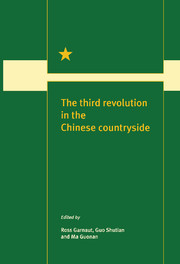Book contents
- Frontmatter
- Contents
- Figures
- Maps
- Tables
- Contributors
- Preface
- 1 The third revolution
- Feeding the people
- Marketing and price reform
- 6 Price reform for agricultural products
- 7 Grain marketing: from plan to market
- 8 Fertiliser price
- 9 Agricultural wholesale markets
- 10 The ‘wool war’ and the ‘cotton chaos’: fibre marketing
- 11 Conflict over cabbages: the reform of wholesale marketing
- Internationalisation
- Regional issues
- Institutional change
- References
- Index
6 - Price reform for agricultural products
from Marketing and price reform
Published online by Cambridge University Press: 04 August 2010
- Frontmatter
- Contents
- Figures
- Maps
- Tables
- Contributors
- Preface
- 1 The third revolution
- Feeding the people
- Marketing and price reform
- 6 Price reform for agricultural products
- 7 Grain marketing: from plan to market
- 8 Fertiliser price
- 9 Agricultural wholesale markets
- 10 The ‘wool war’ and the ‘cotton chaos’: fibre marketing
- 11 Conflict over cabbages: the reform of wholesale marketing
- Internationalisation
- Regional issues
- Institutional change
- References
- Index
Summary
Agricultural product price reform has been crucial within rural economic reform, and represents a fundamental test of whether a socialist market economy can be established successfully in China's rural areas. Changes to the system of pricing agricultural output have also played an important role in economic reform and development throughout the Chinese economy. Successful price reform is necessary to motivate wider systemic reform during the process of establishing a market economy in rural areas.
Three stages in the reform of agricultural product prices
China's agricultural product price reform has been proceeding gradually since rural reform was initiated at the end of 1978. The scope of reform widened over time, and its objectives became more explicit. Reform of agricultural product prices has now reached a critical stage.
The evolution of China's system of pricing agricultural output can be divided into three distinct but closely related stages. The first was dominated by adjustment of state prices. The second included both adjustments to government-set prices, and partial price liberalisation. The third has involved deliberate transformation of the price setting mechanism towards reliance on markets.
The first stage occurred between 1979 and 1984. The main thrust of reform was to raise the prices of agricultural products against those of industrial output, and to adjust relative prices within the farm sector, with the aim of stimulating agricultural development.
- Type
- Chapter
- Information
- The Third Revolution in the Chinese Countryside , pp. 81 - 88Publisher: Cambridge University PressPrint publication year: 1996



